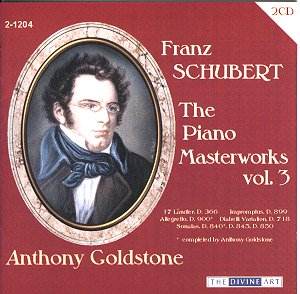Anthony Goldstone, a noted Schubertian, here
presents his third and final volume of Schubert recordings for
The Divine Art label. The playing, the booklet notes (Goldstone,
commendably, writes his own) and the whole production speak of
a dedication which is entirely praiseworthy. Each disc works as
a listening entity in its own right: in each case, some lesser-known
pieces introduce the relative heft of more major works (three
sonatas and the D899 Impromptus). Goldstone has also completed
several pieces (an approach also taken by the Cypriot pianist
Martino Tirimo in his Schubert survey).
The set of seventeen Ländler that
open this collection is immediately attractive. Goldstone responds
with a light touch. Agogic accents are nicely judged, and there
is a fair range of colour and emotion present: there is plenty
of room for Schubertian pathos within the form of the Ländler,
it would seem. The clean fingerwork and careful pedalling are
in fact typical of Goldstone’s playing throughout this set. The
recording is a model of clarity, retaining at the same time the
fullness of the piano tone.
The four Impromptus, D899, are, of course,
well represented in the catalogue. Goldstone’s innate musicality
is ever-present here, from the arresting opening (contrasting
with the almost recitative-like single line melody) to the smooth
and even E flat (No. 2). Goldstone generates a fair amount of
drama in No. 1 (C minor), but it is in No. 2 (E flat) that her
really seems to enjoy himself, relishing the dissonances and letting
us enjoy his finger legato. If the inner parts could have been
even more serene in No. 3 (the famous G flat), there is good left-hand
definition (he uses less pedal than is often the case). The A
flat is the only disappointing one. More fantasy would have opened
up the recesses of Schubert’s mind more (there is a hint of clumsiness
on occasion). Even the end does not bring with it a sense of completion.
The sense of dramatic tension Goldstone brings
to the A minor Sonata, D845, is more than welcome. This is quite
a stormy view that refuses to relax where many might be tempted
(incidentally, though, the final two chords appear to be rather
clumsily edited on). The Andante, poco mosso sounds studied (I
wished for more Olympian calm here). Goldstone is at his best
in the cheeky Scherzo with its gently rocking Trio: the finale,
despite its determination, does not turn out to be the cumulative
experience it should be.
The Allegretto in C minor that opens the second
disc (a Goldstone completion), despite its marking, carries a
sadness with it not normally associated with this tempo indication.
The Diabelli Variation, D718, is a minor-key miniature
that manages to be essentially Schubertian without giving any
clue as to what Beethoven might do in his towering set.
There is a lot to be said for performing the
C major Sonata, D840, as a torso. Of the first movement, Goldstone
sounds as if he is rushing on occasion, at others as if he is
rhythmically stuck. Perhaps he also needs a more rounded tone
if the quasi-orchestral sonorities are going to convince. Nevertheless,
he evokes a Winterreise-like loneliness for the Andante.
If only he had more variety of keyboard colour, he might be able
to truly enter into this world (try Uchida, Philips 454 453-2).
Of the final two movements, the Menuetto, determined and dramatic,
is the most successful; the finale just seems to run out of steam.
The set finishes with the D major Sonata, D850.
The first movement is very fast indeed, so that semiquavers can
emerge garbled. There are, however, some grand, full-toned sonorities
which are well reproduced by this recording. If Goldstone misses
the calm of the second movement and the grandeur of the third,
the music-box opening of the finale is enchanting. Unfortunately,
as the music progresses it does rather sound as if it is going
to run away with itself.
A set that generates mixed reactions, alas. There is much interest
to be found in the smaller pieces. It is just that one is rarely
aware of the true stature of Schubert’s genius while listening to
these performances. For this, one should move towards Uchida or
Brendel, for example.
Colin Clarke

![]() Anthony Goldstone
(piano).
Anthony Goldstone
(piano).![]() THE DIVINE ART 2-1204 [148’22:
71’49+76’33]
THE DIVINE ART 2-1204 [148’22:
71’49+76’33]